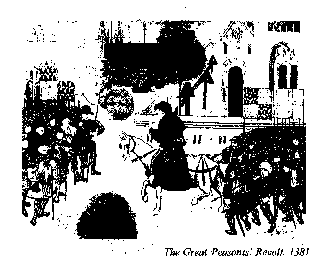
25
economic, social, political and military status. Violence was sparked off by yet another polltax of 1381. People
revolted against the tax-collectors and judges, in the south and south-east of England. The rebels, led by Wat
Tyler and John Ball, a clergyman, marched to London, captured the Tower with the help of Londoners, killed
the archbishop of Canterbury and the Lord Chancellor. John Ball was a radical opponent of the Church-lords
and supported the ideas of John Wycliffe, the first reformer of the Church (1330–1384). He preached ideas of
social justice: "When Adam delved and Eve Span who was then the gentleman?"
The Peasants' Revolt made far reaching demands: a charter of liberties, the end of all lordship except the
King's, the end of serfdom, return of church land to people, etc.
The young King Richard II met the Kentismen face-to-face at Smithsfield. Wat Tyler was pronouncing their
demands which were unacceptable to feudalism.
The King appeared to agree but during the negotiations Wat Tyler was treacherously killed and his head, set
up on a spear, was shown to the rebels to persuade them to retreat from London and disband. Shocked and
morally destroyed they obeyed only to be physically tortured and executed, John Ball was hanged. The punitive
actions continued long into autumn. The Great Peasants' Revolt was defeated. But the ruling class had been
badly frightened and the unpopular Poll Tax withdrawn.
Through a primitive faith in the King (a kindly king) senior lords prevented the peasants from any attempts
to establish their power. But the rebellion undermined the strength and rule of the feudal class and as a
consequence few barons dared to refuse the peasants attempts to buy freedom. Actually, peasant dependence in
Britain disappeared by the 15th century and the Wat Tyler rebellion was instrumental in that.
King Richard II (1377-1399) after considerable civil struggle, eventually wrested the power from Parliament
and the barons. He seems to have pursued a policy of revenge and high-handed despotism.
He brought Duke John of Lancaster's son Henry to England, but Henry gained enough support to take King
Richard prisoner and cause him to abdicate in his favour. The House of Lancaster's Henry IV (1399-1413),
Henry V (1413-1422), Henry VI (1422-1461)– were followed by the kings of the York family – two Edwards:
Edward IV and Edward V, and Richard III, a hunch back, a cruel monster, deformed in body, mind and soul
according to the Tudor historians).
There is a statement, that King Richard II was the last King from the House of Plantagenets – he was
deposed and dethroned by the House of Lancaster. But it is to be stressed, that the two new royal branches
were related to the Plantagenets, were the derivatives of the main stem.
The 13th century was described by historians as a Plantagenet spring after a grim Norman winter. It was the
century of the new gothic style in architecture, of Salisbury Cathedral, foundation of universities, the
development of the Common Law & the Parliament, and the emergence of English as the language of the
nation. The symbol of this spring can be seen in the lyrics "Summer is icumen in". But the following two
centuries were filled with wars, discord and discontent.
The 14th century – brought the disasters of the Hundred Years War (1337-1453) the Peasants' Revolt 1381,
the extermination of the population by the Black death (1348-1349) and punitive execution of the participants,
with positive achievements in literature (Geoffrey Chaucer completes the Canterbury Tales (1393)),–
architecture,– and further strengthening of the English language.

